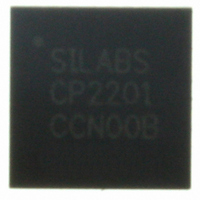CP2201-GM Silicon Laboratories Inc, CP2201-GM Datasheet - Page 37

CP2201-GM
Manufacturer Part Number
CP2201-GM
Description
IC ETH CTRLR SNGL-CHIP 28QFN
Manufacturer
Silicon Laboratories Inc
Specifications of CP2201-GM
Package / Case
48-TQFP, 48-VQFP
Controller Type
Ethernet Controller, MAC/10Base-T
Interface
Parallel/Serial
Voltage - Supply
3.1 V ~ 3.6 V
Current - Supply
75mA
Operating Temperature
-40°C ~ 85°C
Mounting Type
Surface Mount
Ethernet Connection Type
1000BASE-T or 100BASE-T or 10BASE-T
Minimum Operating Temperature
- 40 C
Mounting Style
SMD/SMT
Product
Ethernet Controllers
Standard Supported
IEEE 802.3
Data Rate
10 Mbps or 100 Mbps or 1000 Mbps
Maximum Operating Temperature
+ 85 C
No. Of Ports
1
Ethernet Type
IEEE 802.3
Interface Type
Parallel
Supply Current
60mA
Supply Voltage Range
3.1V To 3.6V
Operating Temperature Range
-40°C To +85°C
Rohs Compliant
Yes
Lead Free Status / RoHS Status
Lead free / RoHS Compliant
For Use With
336-1326 - KIT REF DESIGN PWR OVER ETHERNET336-1316 - KIT EVAL FOR CP2201 ETH CTRLR
Lead Free Status / Rohs Status
Lead free / RoHS Compliant
Other names
336-1313
Available stocks
Company
Part Number
Manufacturer
Quantity
Price
Company:
Part Number:
CP2201-GM
Manufacturer:
SiliconL
Quantity:
48
Part Number:
CP2201-GMR
Manufacturer:
SILICON LABS/芯科
Quantity:
20 000
9. Reset Sources
Reset circuitry allows the CP2200/1 to be easily placed in a predefined default condition. Upon entry to this reset
state, the following events occur:
The contents of the transmit and receive buffers are unaffected by a reset as long as the device has maintained
sufficient supply voltage. However, since the buffer pointers are reset to their default values, the data is effectively
lost unless the host processor has kept track of the starting address and length of each packet in the buffer.
The CP2200/1 has five reset sources that place the device in the reset state. The method of entry to the reset state
determines the amount of time spent in reset and the behavior of the /RST pin. Each of the following reset sources
is described in the following sections:
Upon exit from the reset state, the device automatically starts the external oscillator and waits for it to settle (this
step is skipped on software reset). Once the crystal oscillator settles, the Oscillator Initialization Complete interrupt
occurs (interrupt pin asserted), and the host processor may now access the internal registers to poll for the Self
Initialization Complete Interrupt. If the host does not have access to the interrupt signal, it should wait
approximately 1 ms after the rising edge of reset pin prior to polling the internal registers. Note that the reset pin
could remain low up to 100 ms depending on the power supply ramp time.
The device is fully functional after the Self Initialization has completed. See “6.2. Reset Initialization” on page 18 for
the recommended initialization procedure following a device reset.
All direct and indirect registers are initialized to their defined reset values.
Digital pins (except /RST) are forced into a high impedance state with a weak pull-up to V
Analog pins (TX+/TX–, RX+/RX–) are forced into a high impedance state without a weak pull-up.
The external oscillator is stopped and /RST driven low (except on a software reset).
All interrupts are enabled.
Power-On
Power-Fail
Oscillator-Fail
External /RST Pin
Software Command
Rev. 1.0
DD
CP2200/1
.
37












